Have you ever wondered why your neighbors’ yards seem to be a hotbed of avian activity, while yours isn’t? We’ve provided some valuable information to help you make well-informed decisions about how to create your own bird habitat.
Wild birds are naturally attracted to areas that provide for most of their basic needs. Ensuring that your outdoor space provides plenty of bird-friendly food, a source for clean water, and desirable shelter for wild birds will create a space they love to visit. And give you the pleasure of viewing them in their natural habitat

Everything is Better with Birds
Besides being enchanting to watch, birds play an important role in our ecosystem. They provide natural pest control. For example, Barn Swallows can consume up to 60 insects an hour. Purple Martins, though said to be voracious mosquito hunters, actually consume less mosquitoes than other avian predators, such as Swallows, Bluebirds, and Baltimore Orioles. Yes, when eating insects, wild birds are definitely higher on the food chain, making them a predator, a quite effective one at that! Wild birds are also necessary for dispersing seeds and pollinating, which in turn creates seeds and new generations of plants. Studies have shown that listening to bird song can actually improve your mental health, reducing stress, and giving your nervous system and brain a respite from the clutter of everyday life.
Taking Action: Preserving Wild Bird Populations in a Changing World
Today, birds are facing increasing threats to their habitat due to climate change, habitat destruction, toxic chemicals, and our dependence on chemical pest control and fertilizers. You can personally make an impact on preserving our wild bird populations by growing bird- friendly plants, providing adequate shelter, and giving them a place to bathe in and drink clean water.
- Food – Feed the birds by choosing plants that provide seed. Though your first instinct may be to deadhead those fading blossoms, allow them to stand as they go to seed; local and migrating birds will need this sustenance throughout the winter. Once spring arrives, cut the flowers back and allow the cycle to begin again.
- Shelter – Choose dense, well-branched bushes and shrubs. These will be an important source of winter shelter for your wild birds. Conifers are a great choice to add to your landscape, as they produce pine cones with seeds, as well as being an evergreen to provide shelter. Some, such as Arborvitae, don’t even require pruning to stand tall and beautiful.
- Water – Birds of all kinds need water. Moving water will prevent stagnation and will not be attractive for mosquito breeding, so we recommend using a bubbler, dripper, or fountain to keep the wild birds happy and healthy. In the winter, if outside water tends to freeze, providing a heated birdbath will be welcome to your bird guests; water that is not frozen can be hard to find during that time of year.
Our Top Picks: Plants for Birds
The following plant choices are aesthetically pleasing, even after the blossoms have gone.
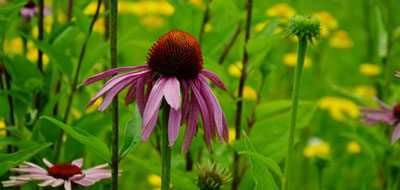
Echinacea, also known as Coneflowers, are easy to grow and a gorgeous part of any perennial flower bed. These perennials are native to a large part of the country and available in a wide variety of colors. Coneflowers provide food for Bluejays, Cardinals, and Goldfinches, just to name a few.
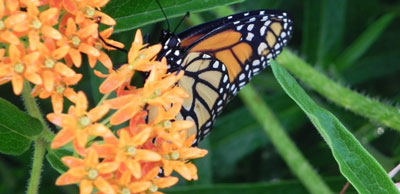
You may not know that Monarch butterflies cannot survive without Asclepias, or Milkweed. Both the Monarch caterpillars and the resulting butterflies need it for food, which helps to keep this beneficial pollinator happy and healthy. Milkweed also attracts a large variety of insects, providing a scrumptious and nutritious meal for wild birds. And that beautiful, white, silky fiber that appears once Asclepias goes to seed? Many wild bird species, such as Goldfinches, Black-Capped Chickadees, Northern Orioles, Vermillion Flycatchers, Baltimore Orioles, and Yellow Warblers, use Milkweed floss to create a silky, soft lining for their nests. Talk about a sustainable plant!

Besides bringing a welcome pop of bright color in hues of blue and purple to your landscape, Asters attract seed eating birds, such as Finches, Nuthatches, Towhees, Cardinals, Goldfinches, and Chickadees. A perennial, Asters are a cousin to the daisy, possessing the same daisy-like petals, most often with a vivid yellow center. Asters are an insect magnet, which means the wild birds will visit often to partake of their deliciousness.
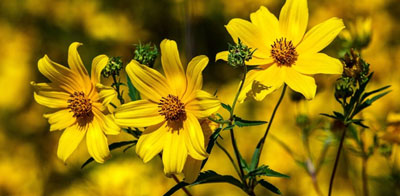
Coreopsis, also known as Tickseed, is a sun loving, drought-tolerant, native wildflower that requires little maintenance. Be aware that some Coreopsis plants are perennial, while others are annual. Tickseed blossoms are always yellow, in shades from pale to bright, though some have brilliant red or orange decoration around their centers. Butterflies love them and the caterpillars of some butterfly species will feast on their leaves. Don’t give in to the urge to destroy those caterpillars; they are butterfly babies and will provide excellent nutrition for wild birds, like Cardinals, Sparrows, Goldfinches, and Chickadees.

Besides adding texture, movement and sound to your yard, the fuzzy spikes of Fountain Grass, also known as Pennisetum, produce seeds that are super attractive to most seed-eating wild birds. Fountain Grass is easily one of the most popular perennial, ornamental grasses. Hailing from Northern Africa and Western Asia, this bunchgrass tolerates heat and drought, growing vigorously in those conditions once established. The plumes will provide nesting material, while the dense foliage can offer protection from predators and a place for backyard birds to take shelter. The smaller seed-eating birds, such as sparrows and finches will enjoy the fluffy seedheads. Fountain grass is also available in a range of colors and forms.
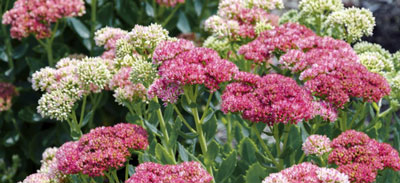
Sedum is a siren call to wild birds, especially when the cooler temperatures of late autumn has the Sedum plant producing bunches of seeds for your wild songbirds. Sedum, also called Stonecrop, is a long-lived, hardy perennial in much of the United States, while in colder climes with harsh winters, it is usually grown as an annual. There are more than 400 Sedum cultivars, so you have a wide choice of colors, not only with the blossoms, but with its foliage as well. As Stonecrop is a succulent, holding water in its leaves, you may find that birds, especially at the height of summer, may munch on the leaves. Your Sedum may look a little raggedy as a result; just remember the birds need water to survive, just as we humans do.

Achillea, or Yarrow, another favorite for perennial gardeners, provides seed for all types of songbirds. This wildflower was first introduced to North America by the colonists who arrived on our eastern borders. Many small songbirds will eat the seeds, while several types of cavity nesting birds, such as Black-Capped Chickadees, White Breasted Nuthatches, and Tufted Titmice, will line their nests with Yarrow. Experiments suggest that Achillea may inhibit the growth of parasites, making it an ideal nesting material.
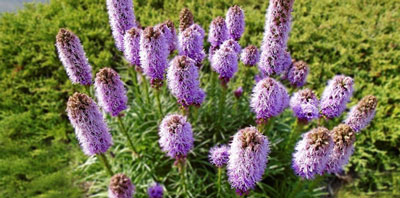
Liatris, also known as Blazing-Star, Gayfeather or Button Snakeroot is native to North America, the Bahamas and Mexico. Besides being a beautiful addition to your outdoor space, its tall spires will go to seed, providing a smorgasbord for all seed-eating backyard birds, like Bluebirds, American Goldfinches, Tufted Titmice, and even Quail and Doves. While in bloom you can expect hummingbirds, bees, and butterflies to be frequent visitors, as each tiny flower has a nectar sack at its base.
Birds Need Shelter Too!

The dense foliage of evergreen Arborvitae provides excellent, much needed shelter for all species of wild birds, particularly those that overwinter in your local area. Arborvitae means “tree of life” in Latin. Cultivars today are as short as 3-feet or can exceed 70-feet in height. Depending on the cultivar, this evergreen can be mounded, rounded, somewhat pyramidal, pendulous, or conical. You have a varied choice when it comes to choosing, but the birds will appreciate the shelter, regardless of the type of Arborvitae that you choose. Shrub or tree, Arborvitae are often grown as property borders or living fences.

Buxus, or Boxwood, shrubs provide thick, dense cover that provides excellent shelter and protection for wild birds and their nests. An evergreen, the Boxwood does not have needles, but rather tiny leaves in abundance. Boxwood shrubs have been a staple in the American landscape for eons, its easy-to-grow nature, deer resistance, and cold-hardiness making it a landscape darling. Though certain cultivars can grow to 20-feet tall and 8-feet wide, you will usually see the smaller cultivars used as hedges around yards or along the foundation of homes. Dwarf and Variegated varieties are the most popular.
So, as you make your garden selections this year, keep your feathered friends in mind – you’ll be rewarded with frequent grateful visitors, delightful song, and some natural stress relief!





























































































































































































































































































































































































































































































































































































































































